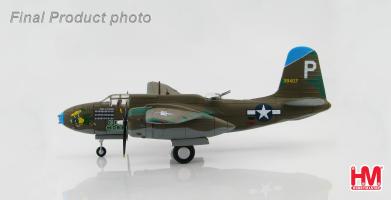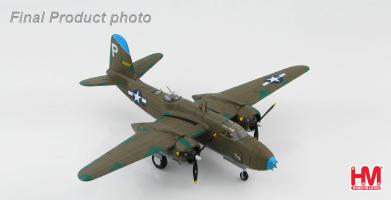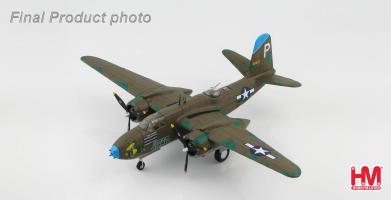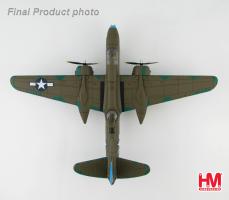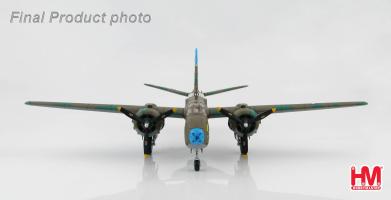Hobby Master Archive
Air Power Propellers 1/72
A-20
Douglas A-20G Havoc 43-9407 "Green Hornet", 675 BS, 417 BG, New Guinea, 1944
With war approaching America knew it would be called upon to aid their Allies so a new aircraft would need to be developed. Douglas Aircraft designer Ed Heinemann’s DB-7/A-20 was chosen to be the new attack-bomber. The prototype flew in December 1938 with the first production aircraft flew on August 17, 1939. Production ran until September 1944 with 7,478 aircraft built. During WWII these were supplied to French, British, Australian, Dutch and Soviet forces as well as their own U.S. Forces.
On March 23, 1943 the 417th Bombardment Group (Light) was constituted and activated on March 28, 1943. This group trained on the Douglas A-20 Havoc in December 1943 and January 1944 before shipping out to the South Pacific and assigned to the 5th AF. In March 1944 the group began supporting ground forces on New Guinea as well as striking at enemy troops, supply depots, airfields and shipping. From September 1944 until they relocated in the Philippines in December 1944 they carried out these operations from Saidor New Guinea against other islands in the chain. Douglas A-20G Havoc 43-9407 was named “Green Hornet” and was assigned to the 675th BS / 417th BG in New Guinea during 1944 - 45. The aircraft was piloted by Lt. J.E. Pryor and crash landed in 1945 and was a write off.
Douglas DB-7 Boston / A-20 Havoc Role - Light Bomber Variants - A,B,C,G,H,J,K First Flight - October 26 , 1938 Entered Service - 1939 Manufacturing Period - 1939 - 1944 Number Built All Variants - 7,098 Douglas A-20G and J specifications Crew - 3 Powerplants G and J - 2 X Wright R-2600-23 Double Cyclone 14 cylinder twin-row air-cooled w/two-speed superchargers rated @ 1,600 hp for take-off, 1,400 hp @ 10,000 ft Performance Speed G and J - Maximum - 339 mph @ 12,400 ft, 317 mph @ 10,000 ft Cruise G - 230 - 272 mph J - 257 mph Initial Climb Rate - G and J / 1,300 fpm Time to 10,000 feet G - 7.1 minutes J - 8.8 minutes Service Ceiling G - 25,800 ft J - 23,100 ft Range With 2,000 lbs of bombs @ 238 mph G - 1,025 miles J - 1,000 miles Maximum Ferry Range G - 2,035 miles J - 2,100 miles
Weights Empty G - 17,200 lbs J - 17,117 lbs Normal Combat Take-off G - 24,000 lbs J - 23,748 lbs Maximum Combat - G and J / 27,200 lbs Maximum G - 30,000 lbs J - 27,000 lbs
Dimensions G and J Length - 48 ft Wingspan - 61 ft 4 in Height - 17 ft 7 in
Armament G 6 X forward-firing 0.50 Colt-Browning machine guns in the nose, 350 rpg 2 X .050 inch machine guns in the dorsal power turret, 400 rpg 1 X 0.50 inch machine gun in ventral tunnel position, 400 rpg Models prior to A-20G-20-DO - 2 0.50 inch machine guns on a flexible dorsal mount Maximum internal bomb-load - 2,000 lbs in split bomb bay + On later models - an additional 2,000 lbs on four under-wing hard-points Armament J 2 X forward-firing 0.50-inch machine guns in lower fuselage 2 X .050 inch machine guns in the dorsal power turret, 400 rpg 1 X 0.50 inch machine gun in ventral tunnel position, 400 rpg Maximum internal bomb-load - 2,000 lbs in split bomb bay + On later models - an additional 2,000 lbs on four under-wing hard-points
Hobby Master 1/72 Air Power Series HA4206 Douglas A-20G Havoc 43-9407 “Green Hornet”, 675 BS, 417 BG New Guinea, 1944
True 1/72 scale. Professionally painted. Great attention to detail. All markings are Tampoed (pad applied). Option to display the model on a stand that is provided. Model can be shown with the landing gear in the down or up positions. Canopy can be removed to place figures inside. Figures included. Dorsal turret can turn. Extremely heavy metal with a minimum of plastic. Highly collectable.
| Added to archive | 2015-11-19 |
| Last modified | 2015-11-19 |
| Leaflet | 2014-05-01 May 2014 |

